Year-in-Review: 2020 Magazine Summary
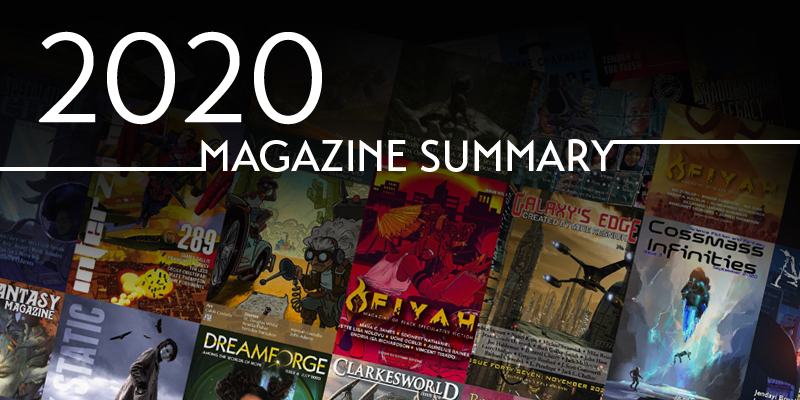
For the summary, the genre magazines are primarily sorted by Hugo Eligibility: Professional, Semiprozine, etc., and then loosely by pay rate, SFWA qualifying market, and the amount of fiction published. We covered 81 magazines, 18 audio sites, and 11 critical magazines.
It’s no surprise that many magazines shut down this year, several went into hiatus or shifted to digital only, but we still added a few new markets to our summary. We asked publishers which Hugo Award category they qualify for or used the data from <semiprozine.org> or our best determination; the information provided this year (or last year) is in brackets at the end of each write up. Any of the editors or publishers named would generally be eligible for Best Editor, Short Form, and the non-fiction magazines would generally be eligible for Related Work.
In our charts we use the Statement of Ownership, required for use of a USPS Periodical Permit, plus numbers as provided, to get subscriber and newsstand sales for those who generate one, though this becomes less meaningful with digital numbers on the rise. Print-plus-digital circulation figures for Analog, Asimov’s, and Locus wrapped in the subscription numbers, keeping sell-through number just for print (since there are no digital returns). There is no digital circulation information from F&SF.
PROFESSIONAL MAGAZINES
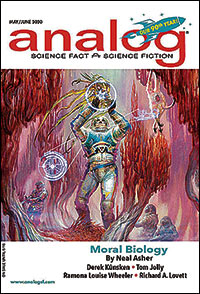 Analog, <www.analogsf.com>, had 9,396 average print subscriptions per month and 8,879 digital, for a total of 18,275, down from last year’s 19,286. Newsstand sales were 2,098, down from 3,176. Paid circulation went down 9.3%; sell-through was 37%, up from last year’s 42.9%.
Analog, <www.analogsf.com>, had 9,396 average print subscriptions per month and 8,879 digital, for a total of 18,275, down from last year’s 19,286. Newsstand sales were 2,098, down from 3,176. Paid circulation went down 9.3%; sell-through was 37%, up from last year’s 42.9%.
Analog produced six tall, digest-size double issues with 208 pages each. Cover price was $7.99. There were three novellas, 17 novelettes, 67 short stories, six reprints, and one serial, for a total of 94 pieces of fiction, down from last year’s 120, plus eight “Science Fact” pieces, one “Probability Zero” piece, and 12 poems. In honor of 90 years of publication, a retro format and logo were adopted for the year’s covers, with excellent quality art including astronauts cataloguing alien species, an iridescent cephalopod, and a woman and a two-headed purple alien floating in zero grav. Editor Trevor Quachri said, “Like many, we’re grateful just to have made it through 2020, healthy and putting out the magazine sans interruption. In 2020, we celebrated our 90th anniversary with a bunch of retrospective reprints of favorite stories and commentary by people close to the magazine like Stanley Schmidt and Ben Bova, as well as rocked a retro cover logo, commissioned covers, and special features on the history of the magazine throughout the year. In 2021, we’ll have a new ongoing logo and tons of great stories, plus an important new endeavor that we can’t talk about quite yet, but which we’re excited to announce in the coming months.” Analog paid 8-10 cents per word for short fiction, and 6 cents per word for serials. [Professional]
 Asimov’s, <www.asimovs.com>, had 6,160 print subscriptions and 10,483 digital subscriptions for a total of 16,643, down from 17,273 last year. Newsstand sales were 2,076, up from 2,415, at 39% sell-through, up from last year’s 36%. Total paid circulation went down 4.9%.
Asimov’s, <www.asimovs.com>, had 6,160 print subscriptions and 10,483 digital subscriptions for a total of 16,643, down from 17,273 last year. Newsstand sales were 2,076, up from 2,415, at 39% sell-through, up from last year’s 36%. Total paid circulation went down 4.9%.
Asimov’s produced six tall, digest-size double issues with 208 pages each. There were 10 novellas, 23 novelettes, 33 short stories, and one reprint, for 67 pieces of fiction, the same number as last year, plus 32 poems. Cover price was $7.99. Covers were of good quality and featured a hyena-headed warrior, a flying Santa, and a moody winter forest scene with a dreaming woman embraced by bare branches. Editor Sheila Williams said, “Although 2020 was a hard year emotionally and a year that provided some real challenges to the magazine, it was a great year for fiction. We published wonderful stories by Neal Asher, Timons Esaias, Sheila Finch, Alaya Dawn Johnson, Ted Kosmatka, Nancy Kress, Derek Künsken, Rich Larson, Michael Libling, Ian MacLeod, Ray Nayler, Julie Novakova, Chen Qiufan, Mercurio D. Rivera, Jason Sanford, Sam Schreiber, Alice Towey, Ian Tregillis, Cadwell Turnbull, Connie Willis, and many others. Emily Hockaday, our part-time assistant Rae Purdom, and I converted to producing the magazine from home almost overnight. We were immensely fortunate to have excellent support from Dell Magazines and our parent company Penny Press. Looking forward to putting 2020 in the rearview mirror and diving in to 2021!” Asimov’s paid 8-10 cents per word. [Professional]
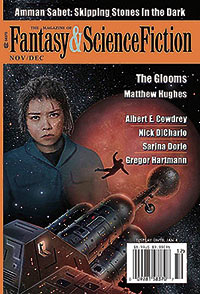 F&SF, <www.sfsite.com/fsf>, showed subscription numbers of 5,257 in its Statement of Ownership, down a little from 5,363 the prior year, with 1,121copies sold on newsstands and sell-through of 36%. Paid circulation was down 13.1%. As always, without digital figures available it’s difficult to say how well the magazine did overall.
F&SF, <www.sfsite.com/fsf>, showed subscription numbers of 5,257 in its Statement of Ownership, down a little from 5,363 the prior year, with 1,121copies sold on newsstands and sell-through of 36%. Paid circulation was down 13.1%. As always, without digital figures available it’s difficult to say how well the magazine did overall.
F&SF produced six digest-size double issues, each 258 pages: four novellas, 24 novelettes, and 38 short stories, for 66 pieces of fiction, same as last year, plus nine poems and some non-fiction. Cover price was $8.99. Cover art was good quality, with an epic painterly space scene, a goblin emerging from a wood-fired brick pizza oven, and a female alien holding a transparent planet Earth in her hands with another figure floating inside.
A number of F&SF stories were nominated for awards, and “The Fourth Trimester is the Strangest” by Rebecca Campbell won the Sunburst. Eleven stories were reprinted in 2020 Year’s Best collections, including volumes from Adams, Clarke, Datlow, Guran, Horton, and Strahan.
The publisher was Gordon Van Gelder and the editor was C.C. Finlay. Next year Sheree Renée Thomas will take the helm as editor with the March/April 2021 issue. Finlay said, “We published a lot of excellent new fiction in 2020, mixing established greats like Bruce Sterling and Tim Powers, with writers currently at the peak of their careers like Leah Cypess and Ian Tregillis, with newcomers like Nadia Afifi, R.S. Benedict, Ashley Blooms, Dare Segun Falowo, and Essa Hansen. The big news, of course, is that I’m stepping down after the Jan/Feb 2021 issue and Sheree is taking over. I am incredibly proud of all the great authors and stories we’ve published in F&SF since I edited my first issue of F&SF back in 2014. The time is right for me to move on, but I can’t imagine anyone else I’d rather hand off the masthead to besides Sheree. She’s accomplished so much already as an editor, and she brings an energy and vision to the magazine that I think our readers are going to love. I know that I’m looking forward to returning to the magazine as a reader, and opening each month’s issue with surprise and anticipation to see what she’s selected.” Thomas said, “I want to continue the wonderful work that’s been done by C.C. Finlay, Gordon, Kris Kathryn Rusch, and all of the other great editors who have added their vision to this historic magazine. I hope to create more space for writers to do the kinds of stories that we don’t always see. I want to get all the good stuff we already know we love in F&SF, and then some new things we might not know we love yet.” Pay rate was 8-12 cents a word. [Professional]
 Locus, <locusmag.com>, we list here since we are professional and have Statement of Ownership numbers in the charts, although we also qualify as Related Work.
Locus, <locusmag.com>, we list here since we are professional and have Statement of Ownership numbers in the charts, although we also qualify as Related Work.
Paid circulation was down 7.8% in 2020, no surprise. Sell-through was up to 56%, up from 47% last year. Bookstores are ordering only what they know they can sell, driving sell-through up and up, and sales numbers down. Subscription numbers held at 2,964, once again mostly flat compared to 2,977 last year.
The print cover price remained $8.99 and digital remained $5.99, with a monthly auto-renew option for $4.99 per issue. Twelve monthly issues in print and electronic formats included reviews, news, convention coverage, book listings, international reports, special features, interviews with new and established authors, and regular commentary from Cory Doctorow and Kameron Hurley on alternating months, with guest commentary from Kelly Lagor in January and March.
We ran 500 reviews of SF, fantasy, horror, and YA fiction, down from 571 last year, including 180 short-fiction venues, plus 13 reviews of notable audiobooks, down from 35. There were four print Spotlight features on Ho Che Anderson, Francesca Myman, We Need Diverse Books, and Fantasy Magazine, and an online promoted spotlight on C. T. Rwizi.
Convention coverage changed from past years in content and implementation due to COVID-19. After our final and only in-person con for the year, FOGcon, we shifted to covering things online: the Nebula Online Conference, WisCon, Flights of Foundry, the Locus Awards Online, The Outer Dark, World Fantasy, the Sirens Conference, and FIYAHCON, plus international cons Worldcon 78: ConNZealand, Chengdu International Science Fiction Conference, the Beijing SF Summit, Chinese New Year SF Gala, Webinar on Science Fiction in India, Celsius 232, Icon, EstCon, and international reports on Brazil, Italy, and India. We added new reviewers Gabino Iglesias and Maya C. James in December 2020 and Alex Brown and Elsa Sjunneson in January 2021. Sponsored book excerpts included Deal with the Devil by Kit Rocha, Repo Virtual by Corey J. White, Unconquerable Sun by Kate Elliott, and By Force Alone by Lavie Tidhar.
Liza Groen Trombi was editor-in-chief; Kirsten Gong-Wong was managing editor. Our website saw increased traffic this year with an average of 2.77 million non-bot sessions per month, up from 1.27 million. [Professional/Related Work]
Tor.com published 46 original stories – 26 short and 20 novelettes, online only, as well as artwork, commentary, non-fiction, and more – with eight original flash pieces and two reprints in collaboration with Fiyah. Publisher was Irene Gallo. Short fiction coordinator Emily Goldman said, “We are especially proud of ‘The Girlfriend’s Guide to Gods’ by Maria Dahvana Headley, a powerful deconstruction of Greek mythology about women coming into their own power, and ‘Everything’s Fine’ by Matthew Pridham, a perfect encapsulation of the horror and chaos of 2020. We are also honored to have published in collaboration with Fiyah literary magazine the flash fiction anthology Breathe Fiyah featuring world-changing SF by Black authors.” It is one of the highest-regarded and best paying markets at $.25 a word, with three to four million page views a month. [Professional]
Terraform, <motherboard.vice.com/terraform>, published four pieces of fiction for 2020, nested deep within the Vice site. Pay rate was $.20/word. [Professional]
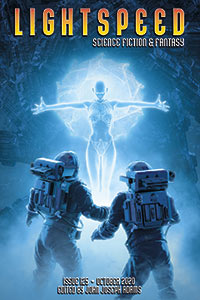 Lightspeed, <www.lightspeedmagazine.com>, Nightmare, and Fantasy are published by Adamant Press, and Lightspeed is edited by John Joseph Adams. Lightspeed produced 12 issues, online and electronic, with 87 short stories/novelettes (47 originals, 48 reprints) – half science fiction and half fantasy – interviews, podcasts, and more. Adams said, ” We’re changing around our nonfiction a bit, discontinuing the feature interview and spreading the book reviews out throughout the month.” Issues were free online, $3.99 for electronic, and $2.99 for subscribers. Average monthly unique visitors were 29,800, with 2,200 subscribers. Pay was $.08/word. [Professional]
Lightspeed, <www.lightspeedmagazine.com>, Nightmare, and Fantasy are published by Adamant Press, and Lightspeed is edited by John Joseph Adams. Lightspeed produced 12 issues, online and electronic, with 87 short stories/novelettes (47 originals, 48 reprints) – half science fiction and half fantasy – interviews, podcasts, and more. Adams said, ” We’re changing around our nonfiction a bit, discontinuing the feature interview and spreading the book reviews out throughout the month.” Issues were free online, $3.99 for electronic, and $2.99 for subscribers. Average monthly unique visitors were 29,800, with 2,200 subscribers. Pay was $.08/word. [Professional]
Nightmare, <www.nightmare-magazine.com>, also helmed by Adams, published 12 monthly issues, online and electronic, with 48 horror and dark fantasy stories (24 originals and 24 reprints). Incoming editor-in-chief Wendy N. Wagner said she’d like to see “more poetry and creative nonfiction submissions.” Issues were free online, $3.99 for electronic, and $2.99 for subscribers. Pay was $.08/word. Average monthly uniques were 11,300 and 1,400 ebook subscribers. [Professional]
Fantasy, <www.fantasy-magazine.com>, co-edited by Christie Yant & Arley Sorg, relaunched in November, publishing two monthly issues, online and electronic, with four original fantasy stories, four flash pieces, and four poems. “Writers should write what is important to them: Tell the stories you need to tell, and do it well. Sometimes we end up liking a story we didn’t expect to like. That said, it would be great to see EVEN MORE BIPOC authors and characters, deep relationships and conflict, that aren’t romantic in nature, and thoughtfully drawn protagonists over 50.” Issues were free online, $3.99 for electronic, and $2.99 for subscribers. Pay was $.08/word. [Professional]
 Clarkesworld, <clarkesworldmagazine.com>, published 12 online, electronic, and print issues, with 76 pieces of original fiction (44 short stories, 30 novelettes, two novellas, all with podcast editions) and 48 pieces of non-fiction. Eleven of the original stories were in translation from Chinese, Japanese, Korean, and Spanish. Covers were high quality, original art. Publisher was Neil Clarke. Clarke said “‘Give the Family My Love’ by A.T. Greenblatt won the Nebula Award for Best Short Story. Plans for 2021 include having an open submission window for Spanish-language submissions.” The website had 43,000 unique visitors per month, and there were around 3,850 digital subscribers and 200-250 digital single-issue sales monthly, same as last year. Print cover price remained $7.99; electronic issues were $3.99 or $2.99 with subscription, same as last year. Clarkesworld pays $.10/word. [Professional]
Clarkesworld, <clarkesworldmagazine.com>, published 12 online, electronic, and print issues, with 76 pieces of original fiction (44 short stories, 30 novelettes, two novellas, all with podcast editions) and 48 pieces of non-fiction. Eleven of the original stories were in translation from Chinese, Japanese, Korean, and Spanish. Covers were high quality, original art. Publisher was Neil Clarke. Clarke said “‘Give the Family My Love’ by A.T. Greenblatt won the Nebula Award for Best Short Story. Plans for 2021 include having an open submission window for Spanish-language submissions.” The website had 43,000 unique visitors per month, and there were around 3,850 digital subscribers and 200-250 digital single-issue sales monthly, same as last year. Print cover price remained $7.99; electronic issues were $3.99 or $2.99 with subscription, same as last year. Clarkesworld pays $.10/word. [Professional]
There were 12 issues of Forever, <forever-magazine.com>, Clarke’s “reprint only” project, each featuring a novella and two short stories. The magazine was available in digital formats for $2.99 per issue or by subscription. [Professional]
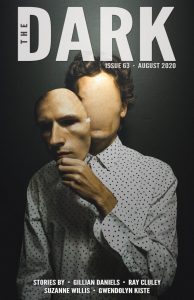 The Dark Magazine, <www.thedarkmagazine.com>, published 48 “dark and strange” stories, 27 originals and 21 reprints, in 12 issues, online and electronic, co-edited by Sean Wallace & Silvia Moreno-Garcia. Wallace said, “The readership seems to be happy with the direction of the magazine, with more and more diverse representation, and the hope is that we continue to receive more international submissions, whenever possible, whether that be in the slushpile, with active solicitation, or even with specific translation commissions.” December was Moreno-Garcia’s last issue. Issues were free online, $2.99 for ebook, $1.99 for subscribers. There were about 4,000 uniques monthly, with 960 paid subscribers. Pay was $.06/word. [Professional]
The Dark Magazine, <www.thedarkmagazine.com>, published 48 “dark and strange” stories, 27 originals and 21 reprints, in 12 issues, online and electronic, co-edited by Sean Wallace & Silvia Moreno-Garcia. Wallace said, “The readership seems to be happy with the direction of the magazine, with more and more diverse representation, and the hope is that we continue to receive more international submissions, whenever possible, whether that be in the slushpile, with active solicitation, or even with specific translation commissions.” December was Moreno-Garcia’s last issue. Issues were free online, $2.99 for ebook, $1.99 for subscribers. There were about 4,000 uniques monthly, with 960 paid subscribers. Pay was $.06/word. [Professional]
Galaxy’s Edge, <www.galaxysedge.com>, was edited by Lezli Robyn and published by Shahid Mahmud. Founding editor was Mike Resnick (1942-2020), to be honored on the cover indefinitely with a byline reading “Created by Mike Resnick.” There were six print issues between 102-122 pages, 19 x 24.5 cm, perfect bound, with b&w interiors on book print and color matte covers, including one with an alien waving farewell to Mike Resnick for a special commemorative issue, with 69 works of short fiction total, one serial installment, and 23 pieces of non-fiction. There were 8,000 average unique monthly website visitors, unchanged from last year, and 750 subscriptions (digital and paper, including trial subs), down from 1,000. Fiction was free online, print cover price was $7.99, ebook $4.99. Pay rate was $.07/word for new fiction. [Professional]
Fiction River, <www.fictionriver.com>, an “original anthology magazine,” produced two tall, digest-size regular print issues at 246 pages, perfect bound with glossy color covers and b&w interiors, with 26 pieces of fiction, all original. Themes were “Doorways to Enchantment” and “Stolen”; series editors were Kristine Kathryn Rusch & Dean Wesley Smith. Publisher Allyson Longueira of WMG Publishing said, “Well, 2020 was an unprecedented year, to put it mildly. But we managed to keep all of our staff employed and still release 30 titles, including these magazines, so I consider that a win.” Cover price was $15.99, $6.99 for ebook, less for subscribers. Pay rate was $.06-$.10/word. [Professional]
We saw two perfect-bound, 17.5 x 25.5 cm issues of Pulphouse, <pulphousemagazine.com>, 168 pages, glossy color covers and b&w interiors, with 36 short stories, of which 21 were original. Editor was Dean Wesley Smith, with executive editor Kristine Kathryn Rusch. Publisher was Allyson Longueira. Cover price was $9.99, up from $7.99, $5.99 for ebook, up from $4.99. Pay rate was $.06-$.10/word. [Professional]
SEMIPROZINE
These are our semiprozine fiction venues. There are a ton, loosely organized by pay rate and quantity of stories printed. SFWA qualifying status is now $.08/word, so about the first half of the semiprozines qualify.
Fireside was available electronically and, in print, as Fireside Quarterly: four tall, digest-size issues with matte spot color illustrations and excellent quality full-color glossy art on triple gatefold inserts, 106-122 pages with 55 short stories, one poem, and some non-fiction, followed by monthly ebook Fireside Magazine, after which each story was posted online, one per week, at <firesidefiction.com>. Pablo Defendini was publisher and art director; guest editors were Dominik Parisien, L.D. Lewis, Kate Dollarhyde, and Maurice Broaddus. Defendini stepped down as publisher but remains art director after posting an offensive and racist audio recording online. Defendini apologized and Brian J. White, founding editor/publisher, has stepped in as interim editorial director until a new hire can be made. As part of the ensuing restructuring, the print edition of the magazine has been discontinued indefinitely, making Autumn 2020 the final issue of Fireside Quarterly. Unique visitors averaged around 10,000 per month, down from 14,000, and a circulation of 1,000 for Fireside Quarterly, available by subscription for $120 per year. Pay rate was 12.5 cents per word. [Semiprozine]
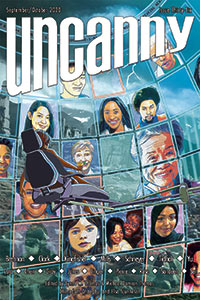 Uncanny, <uncannymagazine.com>, published six issues, online and electronic, with 37 original stories and five reprints, as well as essays, poems, interviews, and podcasts. Lynne M. Thomas & Michael Damian Thomas were co-editors-in-chief. The mag won its fifth Semiprozine Hugo Award. Tananarive Due’s essay “Black Horror Rising” won the 2020 Ignyte Award for Best in Creative Nonfiction. Uncanny stories were finalists for Hugo, Nebula, Locus, Sturgeon, Ignyte, and World Fantasy Awards, and the Thomases were finalists for Hugo, World Fantasy, and Locus Awards. They also successfully funded their seventh Kickstarter. “The stories with the best responses were ones with gorgeous prose and wonderful characters that elicited strong emotions from the readers. We always want to see more own-voices stories.” Issues were free online, $3.99 for electronic, and $1.99 for subscribers. Uncanny had 2,300 subscribers and averaged 40,200 uniques. Pay was $.10/word for fiction. [Semiprozine]
Uncanny, <uncannymagazine.com>, published six issues, online and electronic, with 37 original stories and five reprints, as well as essays, poems, interviews, and podcasts. Lynne M. Thomas & Michael Damian Thomas were co-editors-in-chief. The mag won its fifth Semiprozine Hugo Award. Tananarive Due’s essay “Black Horror Rising” won the 2020 Ignyte Award for Best in Creative Nonfiction. Uncanny stories were finalists for Hugo, Nebula, Locus, Sturgeon, Ignyte, and World Fantasy Awards, and the Thomases were finalists for Hugo, World Fantasy, and Locus Awards. They also successfully funded their seventh Kickstarter. “The stories with the best responses were ones with gorgeous prose and wonderful characters that elicited strong emotions from the readers. We always want to see more own-voices stories.” Issues were free online, $3.99 for electronic, and $1.99 for subscribers. Uncanny had 2,300 subscribers and averaged 40,200 uniques. Pay was $.10/word for fiction. [Semiprozine]
Strange Horizons, <www.strangehorizons.com>, published 53 weekly online issues with 54 short stories (including eight translations), three novelettes, poetry, reviews, and articles. Editor-in-chief Vanessa Rose Phin said, “We ran our highest-grossing fund drive ever in June 2020, and were nominated for the Hugo for best semiprozine for the 8th year in a row (our tenth Hugo nomination as a website). The biggest event for us as a team was winning the inaugural Ignyte Community Award for Outstanding Efforts in Service of Inclusion and Equitable Practice in Genre, which touched us all. We ran four special issues this year: climate crisis in March, chosen family in July, our 20th-anniversary special in August, and Mexican SF in November. The Mexican SF issue was the largest issue in our 20-year history.” Strange Horizons had about 78,000 hits/month (not unique visitors), and over 1,000 downloads per week from the podcast. Payrate was $.10/word for fiction. [Semiprozine]
Strange Horizons‘s sister magazine Samovar, “a quarterly magazine of and about translated speculative fiction,” edited by Sarah Dodd, Laura Friis & Greg West, produced three online issues with six stories and their accompanying translations. Pay rate was $.08/word.
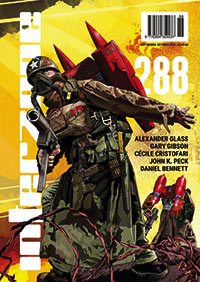 Interzone and Black Static, <www.ttapress.com>, from TTA Press are two respected genre UK print and electronic publications edited by Andy Cox, a fixture of the field. Interzone had five print issues, 17 x 24 cm, perfect bound, with 96 pages and a glossy color cover; interiors were color on uncoated stock. There were 17 short stories and seven novelettes for 24 pieces of fiction, down from 35, plus book and film reviews and other non-fiction. Covers by Warwick Fraser-Coombe were colorful futuristic military scenes. Cover price for subscribers was £5.99/print (£7.00 for individual back issues online), £4.99/ebook. [Semiprozine]
Interzone and Black Static, <www.ttapress.com>, from TTA Press are two respected genre UK print and electronic publications edited by Andy Cox, a fixture of the field. Interzone had five print issues, 17 x 24 cm, perfect bound, with 96 pages and a glossy color cover; interiors were color on uncoated stock. There were 17 short stories and seven novelettes for 24 pieces of fiction, down from 35, plus book and film reviews and other non-fiction. Covers by Warwick Fraser-Coombe were colorful futuristic military scenes. Cover price for subscribers was £5.99/print (£7.00 for individual back issues online), £4.99/ebook. [Semiprozine]
There were five print issues of Black Static, 17 x 24 cm, perfect bound, with 96 pages, a glossy color cover, and b&w interiors. Five novelettes and 22 short stories added up to 27 pieces of fiction, down from 35 last year, plus reviews and other non-fiction. Covers were of good quality, from a noir cityscape to a man in a bloodstained tux holding roses in front of his face. Cover price for subscribers was £5.99/print (£7.00 for individual back issues online), £4.99/ebook. TTA remains one of the few fiction markets that does not disclose pay rates. [Semiprozine]
Diabolical Plots, <www.diabolicalplots.com>, edited by David Steffen, published 24 stories in 12 monthly online issues, plus reprints in The Long List Anthology Volume 6. Steffen said, “For the January window, Ziv Wities will be taking on the role of assistant editor for the first time and handling more of the first-round submissions to help manage time for the submission window. Hopeful fun stories like John Wiswell’s ‘Open House On Haunted Hill’ and Maria Haskin’s ‘Tony Roomba’s Last Day On Earth’ seemed to be especially well received.” Pay was $.10/word, $.01/word for reprint fiction + royalty share for the anthology. Uniques/month averaged about 7,000, with over 500 newsletter subscribers. [Semiprozine]
Lady Churchill’s Rosebud Wristlet, <smallbeerpress.com/lcrw>, produced two saddle-stitched, oversize chapbooks, with b&w covers and interiors, 64-68 pages, with seven short stories, one novella, and two poems. Print subscriptions increased to 280 from 220; ebook subscriptions stayed steady at 80. Co-editors were Gavin J. Grant & Kelly Link. Of 2021, Grant says, “It’s been 14 years since we last raised prices, so on 1/1/21 the cover will rise to $6.00 ($3.99 ebook).” Cover price was $5.00, $2.99 for ebook. Pay rate was $.03/word, $25 minimum, and $10/poem. [Semiprozine]
 Beneath Ceaseless Skies, <www.beneath-ceaseless-skies.com>, a biweekly “literary adventure fantasy” magazine published and edited by Scott H. Andrews, produced 26 online issues containing 41 short stories, 17 novelettes, and two novellas for a total 60 pieces of original fiction and 20 podcast episodes, including their 12th-anniversary double-issue, a fifth biannual science-fantasy theme month in February, and their 300th issue in March. Andrews said, “Accolades included an eighth Hugo finalist for Best Semiprozine and ‘Do Not Look Back, My Lion’ by Alix E. Harrow a Hugo finalist for Best Short Story.” The website averaged 64,000 uniques per month; podcasts averaged 14,000 downloads per episode. Pay rate was $.08/word. [Semiprozine]
Beneath Ceaseless Skies, <www.beneath-ceaseless-skies.com>, a biweekly “literary adventure fantasy” magazine published and edited by Scott H. Andrews, produced 26 online issues containing 41 short stories, 17 novelettes, and two novellas for a total 60 pieces of original fiction and 20 podcast episodes, including their 12th-anniversary double-issue, a fifth biannual science-fantasy theme month in February, and their 300th issue in March. Andrews said, “Accolades included an eighth Hugo finalist for Best Semiprozine and ‘Do Not Look Back, My Lion’ by Alix E. Harrow a Hugo finalist for Best Short Story.” The website averaged 64,000 uniques per month; podcasts averaged 14,000 downloads per episode. Pay rate was $.08/word. [Semiprozine]
Daily Science Fiction, <dailysciencefiction.com>, co-published and co-edited by Michele-Lee Barasso & Jonathan Laden, published 260 stories, including “2-3 foreign translations” in reprint, online, and by email delivery. Pay was $.08/word up to 1,500 words. They reported 20,000 visitors per month; 14,000 email subscribers. [Semiprozine]
 Fiyah, <www.fiyahlitmag.com>, the “Magazine of Black Speculative Fiction,” published 17 original stories plus ten poems in four scheduled electronic issues, as well as hosting the inaugural FIYAHCON and Ignyte Awards. Executive editor DaVaun Sanders said, “Outside of our themed issues, I’m always interested to see fresh takes in science fiction, and stories across genres that interact with climate change. I’d also love to see more novelettes!” Pay was $.08/word for fiction, with 1,769 subscribers and “13,953-ish” unique views/month. [Semiprozine]
Fiyah, <www.fiyahlitmag.com>, the “Magazine of Black Speculative Fiction,” published 17 original stories plus ten poems in four scheduled electronic issues, as well as hosting the inaugural FIYAHCON and Ignyte Awards. Executive editor DaVaun Sanders said, “Outside of our themed issues, I’m always interested to see fresh takes in science fiction, and stories across genres that interact with climate change. I’d also love to see more novelettes!” Pay was $.08/word for fiction, with 1,769 subscribers and “13,953-ish” unique views/month. [Semiprozine]
Abyss & Apex Magazine, <www.abyssapexzine.com>, published 25 original stories, plus book reviews, editorials, and poems in four quarterly issues. Editor and publisher Wendy S. Delmater said, “We saw a serious shift in reader interest from our science fiction to our fantasy stories in 2020. Nevertheless, we would like to see more science fiction in our slush: fantasy submissions outnumber sci fi ones by a margin of 5:1.” Average unique visitors per month was 11,080. Pay was $.08/word to 1,000 words, with a max of $80. [Semiprozine]
Mysterion, <www.mysteriononline.com>, edited and published by Donald S. Crankshaw & Kristin Janz, published 14 stories in blog format: two reprints and 12 originals. “We’d love to see more humor, more optimistic and hopeful stories, more far-future science fiction and stories about non-humanoid aliens, more stories where the protagonist is not a priest or minister and does not encounter an angel, and more stories by and about Christians in and from Africa, Asia, and Latin America as well as diaspora communities with connections to those regions.” Pay was $.08/word for originals, $.04/word for reprints, with 400 average unique visitors per month and 1,300 hits per month. [Semiprozine]
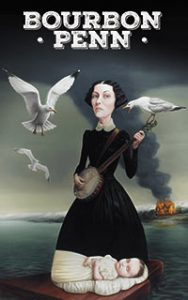 Bourbon Penn produced three perfect-bound issues, 12.75 x 20 cm, 153-160 pages, with color, glossy covers with excellent quality surrealist art and b&w interiors, with 19 original short stories, also available in ebook and for free at <www.bourbonpenn.com>. Editor Erik Secker said, “We increased our pay rates for fiction. Online traffic increased about 60%, but digital and print sales decreased nearly 50%. The story ‘Song for the Unraveling of the World’ served as the title story for Brian Evenson’s World Fantasy and Shirley Jackson award-winning collection.” Print cover price is $12.95; ebook $2.99. Pay rate went up to $.02/word. [Semiprozine]
Bourbon Penn produced three perfect-bound issues, 12.75 x 20 cm, 153-160 pages, with color, glossy covers with excellent quality surrealist art and b&w interiors, with 19 original short stories, also available in ebook and for free at <www.bourbonpenn.com>. Editor Erik Secker said, “We increased our pay rates for fiction. Online traffic increased about 60%, but digital and print sales decreased nearly 50%. The story ‘Song for the Unraveling of the World’ served as the title story for Brian Evenson’s World Fantasy and Shirley Jackson award-winning collection.” Print cover price is $12.95; ebook $2.99. Pay rate went up to $.02/word. [Semiprozine]
We saw three issues of On Spec, <www.onspecmag.wordpress.com>, a Canadian print digest, 120-138 pages, perfect bound, including 24 stories and six poems, all original, and assorted non-fiction. Semi-gloss covers ranged from an African diorama atop a zebra’s back to a striking spaceship scene in an asteroid belt. Diane L. Walton was managing editor and The Copper Pig Writers’ Society was publisher. Walton said, “This year, in response to COVID and the hit taken by much of Alberta’s magazine industry, we were all spared the chore of applying for grant funding, and the government’s Arts Branch sent every magazine a one-time payment of the equivalent of 2 years’ worth of funding.” Average print run was 400, same as last year, with almost all print sales direct to subscribers. The magazine was available in PDF, mobi, and epub from Weightless. Regular issue price was C$6.95. Pay rates ran from C$.03 to C$.125/word. [Semiprozine]
 Future Science Fiction Digest, <future-sf.com>, published four issues with 16 original stories and three reprints “with a strong focus on translation and international fiction.” Editor Alex Shvartsman said, “We lost our sponsorship in late 2019 so our first couple of issues of 2020 were really small based on budget. However, this issue has been resolved and our latter two issues were complete, including the oversized East Asia issue published in December.” Pay was $.08/word. There were roughly 3,000 readers per month. Fiction is free online, $2.99/ebook. [Semiprozine]
Future Science Fiction Digest, <future-sf.com>, published four issues with 16 original stories and three reprints “with a strong focus on translation and international fiction.” Editor Alex Shvartsman said, “We lost our sponsorship in late 2019 so our first couple of issues of 2020 were really small based on budget. However, this issue has been resolved and our latter two issues were complete, including the oversized East Asia issue published in December.” Pay was $.08/word. There were roughly 3,000 readers per month. Fiction is free online, $2.99/ebook. [Semiprozine]
We saw three issues of DreamForge, <dreamforgemagazine.com>. Print was 56-73 pages, full-size with matte color covers and color interior on smooth book print, with 40 stories, mostly original, plus a free online Halloween special with 11 stories. Publisher and editor Scot Noel said, “COVID-19 caused issues with family, our day-jobs, and DreamForge. We had to scale back and refocus to continue.” The magazine will be released digitally in 2021 as DreamForge Anvil <dreamforgemagazine.com/anvil/>, with plans for one or two print issues/year. Average print run was 380, up from 300, with 1,150 unique web visitors. Subscription only, $29.99/year for three issues, print plus digital, $19.99 for digital. Pay rate was $.06 to $.08/word. [Semiprozine]
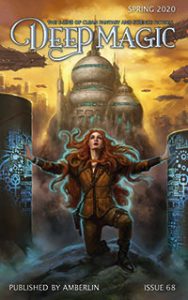 Deep Magic, <deepmagic.co>, “the e-zine of clean fantasy and science fiction,” published 15 stories online in three issues, saying, “On average, 80% of our stories are original.” Pay rate was $.08/word for the first 7,499 words, capped at $599.92. Board member Kristin J. Dawson said, ” Stories with heart always get a great response. However, in 2020 we got strong responses to humor. We always love a great bittersweet tale, but in 2021 we’re keeping a keen eye out for humor and stories with an HEA ending. As always, we want page-turning tension without an emphasis on gore or steamy situations.” [Semiprozine]
Deep Magic, <deepmagic.co>, “the e-zine of clean fantasy and science fiction,” published 15 stories online in three issues, saying, “On average, 80% of our stories are original.” Pay rate was $.08/word for the first 7,499 words, capped at $599.92. Board member Kristin J. Dawson said, ” Stories with heart always get a great response. However, in 2020 we got strong responses to humor. We always love a great bittersweet tale, but in 2021 we’re keeping a keen eye out for humor and stories with an HEA ending. As always, we want page-turning tension without an emphasis on gore or steamy situations.” [Semiprozine]
Cosmic Roots and Eldritch Shores, <cosmicrootsandeldritchshores.com>, edited by Fran Eisemann published 12 online issues with six original stories, two reprints, and 1 poem. Two stories “focusing on the positive and constructive got the best response, and what we’d like to see more of.” There were 3,200 uniques/month, about 300 subscribers, and pay was $.06/word for new fiction, $.02/word for reprints. [Semiprozine]
LampLight, <lamplightmagazine.com>, a dark fiction periodical edited by Jacob Haddon, published 23 original stories, two reprints, and five “public domain classics” in five issues (two in one double issue). “This was a year for ghosts, and re-tellings of classics. I still look forward to dark sci-fi.” Cover price was $7.99/print and $2.99/electronic. Pay was $.03/word to $150 max. [Semiprozine]
Frozen Wavelets, <frozenwavelets.com>, “offspring of The Earthian Hivemind” a dark fiction periodical edited by Steph P. Bianchini, published 18 original stories, two reprints, and poetry in four issues. “We specialise in flash fiction, and speculative horror with a tinge of science-fiction fared the best.” Pay was $.08/word for fiction, $1/line for poetry. [Semiprozine]
Space and Time, <www.spaceandtimemagazine.com>, produced four issues, 48-108 pages, b&w with glossy color covers, with 37 original stories and one reprint, 64 poems, five graphic stories, and assorted non-fiction, available in print, digital, and audio. Angela Yuriko-Smith was publisher and editor-in-chief and Ryan Aussie Smith was publisher and audiopub producer. Yuriko-Smith said, “This was a challenging year for everyone, but, thanks to our dedicated staff, we didn’t miss an issue. Halfway through the year we had to pivot away from the way we had been printing and move to Amazon KDP POD.” Print run for the first two issues was 500/issue with an average of 490 sold (including a handful of POD). Second two issues were POD with an average of 89 sold so far. There were 100 print subscribers and 150-200 digital. The website got 1,000-3,000 hits per month, and unique visitors were around 500-1,000, same as last year. Cover price was $10.00, up from $7.00; $9.99 for ebook subscription. Pay rate was $.01/word, $5.00 per poem. [Semiprozine]
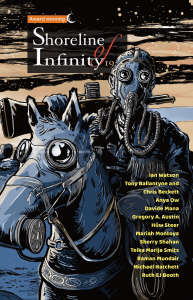 Shoreline of Infinity, <www.shorelineofinfinity.com>, based out of Scotland, published 32 new stories, 22 poems, and 17 pieces of non-fiction in three regular issues, 137-159 pages, all perfect bound, digest-sized with b&w interiors and glossy color covers. Editor Noel Chidwick said, “Despite the best efforts of Covid-19 to slow down our production plans we published three issues of Shoreline of Infinity in 2020. In June we published issue 18 in which we spotlighted BAME science fiction and fantasy. This was guest edited by Tendai Huchu and Raman Mundair, who gathered an exciting mix of stories, poems and features from around the world.” Print run was 180, with 90 subscribers and 100 digital sales/issue. Cover price went up to £8.50 but was available online at £3.50-£3.95 digital/£7.75-£7.95 print, depending on the issue, with 4,700 unique website visitors monthly, up from 3,600. Pay rate was £10/1,000 words. [Semiprozine]
Shoreline of Infinity, <www.shorelineofinfinity.com>, based out of Scotland, published 32 new stories, 22 poems, and 17 pieces of non-fiction in three regular issues, 137-159 pages, all perfect bound, digest-sized with b&w interiors and glossy color covers. Editor Noel Chidwick said, “Despite the best efforts of Covid-19 to slow down our production plans we published three issues of Shoreline of Infinity in 2020. In June we published issue 18 in which we spotlighted BAME science fiction and fantasy. This was guest edited by Tendai Huchu and Raman Mundair, who gathered an exciting mix of stories, poems and features from around the world.” Print run was 180, with 90 subscribers and 100 digital sales/issue. Cover price went up to £8.50 but was available online at £3.50-£3.95 digital/£7.75-£7.95 print, depending on the issue, with 4,700 unique website visitors monthly, up from 3,600. Pay rate was £10/1,000 words. [Semiprozine]
New venue Departure Mirror, <departuremirror.com>, edited by Arthur Robert Tracy IV, published five original stories and two poems in their inaugural issue. They plan to publish quarterly, with book reviews, editorials, and poems. “We like stories that plug into the current cultural zeitgeist without repeating the same old talking points, so right now the thinking among the staff is that ‘upbeat in the face of adversity’ will continue to be popular for at least the first half of the new year.” Pay was $.10/word to 3,000 words, $300 flat plus free ad space for longer stories. [not yet eligible]
We saw two PDF issues of Into the Ruins, <intotheruins.com>, 106-121 pages, with 12 original short stories, on the topic of deindustrial SF and realistic environmental and social speculation. Editor and publisher Joel Caris said, “Into the Ruins wrapped up its four year run in 2020… The magazine maintained a strong base of support to its end and helped to develop the nascent sub-genre of deindustrial science fiction.” Average sales were around 170 per issue. Cover price was $12 for print, $7.50 ebook. Pay rate was $.005/word. [Semiprozine]
GigaNotoSaurus, <giganotosaurus.org>, published 12 fantasy or SF pieces online: “longer than a short story, and shorter than a novel.” Editor LaShawn M. Wanak said, “‘The Air in my House Tastes Like Sugar’ by ZigZag Claybourne got the most responses.” Pay rate was $100/story. [Semiprozine]
Flash Fiction Online, <flashfictiononline.com>, a monthly edited by Suzanne W. Vincent posted 12 scheduled issues with 48 total flash fiction pieces – 36 original and 12 reprints. Publisher Anna Yeatts said, “We currently have five stories listed on SFWA’s Nebula Reading List, including ‘Against the Dying of the Light’ by Stewart C. Baker, ‘Six Dreams About the Train’ by Maria Haskins, ‘The Last Day of the Faith’ by T. R. Seibert, ‘We are the Moor’ by Sylvia Heike, and ‘Mirrored’ by Jennifer Hudak. We love to see all sorts of brief, beautiful, and dynamic stories.” Wendy Nikel will be editor-in-chief beginning January 1. Pay was $0.02/word for reprints, $0.08/word for original stories between 500-1,000 words. They had approximately 30,000 hits per month and 200 subscribers.
James Gunn’s Ad Astra, <www.adastrasf.com>, “the best parts of creative magazines and scholarly journals,” published two issues with 11 stories, including one reprint. James E. Gunn died in December. Editor-in-chief Jean Asselin said, “We’ll grieve the passing of author, scholar, teacher, mentor, and gentleman James E. Gunn for some time. While our friend is irreplaceable, the knowledge that his legacy will endure brings a small measure of comfort.” Pay was $50/story. [Semiprozine]
 Three Crows, <threecrowsmagazine.com>, edited by Alex Khlopenko, published 20 stories (18 original, 2 reprints) in four online issues. “Fantasy/horror and magic realism got the best response, with ‘Potato Face’ being considered for Bram Stoker Award for short fiction…. We have two anthologies scheduled – Best of Year Two (Q1), LGBT Weird Fiction (Q3), and develop a non-fiction collection of essays ‘People’s history of the Weird’.” Pay was $.01/word, with 13,000 average visitors and 30 subscriptions. [Semiprozine]
Three Crows, <threecrowsmagazine.com>, edited by Alex Khlopenko, published 20 stories (18 original, 2 reprints) in four online issues. “Fantasy/horror and magic realism got the best response, with ‘Potato Face’ being considered for Bram Stoker Award for short fiction…. We have two anthologies scheduled – Best of Year Two (Q1), LGBT Weird Fiction (Q3), and develop a non-fiction collection of essays ‘People’s history of the Weird’.” Pay was $.01/word, with 13,000 average visitors and 30 subscriptions. [Semiprozine]
Augur, <www.augurmag.com>, an online literary spec-fic magazine, published 14 original stories, two comics, and 16 poems in two issues. Lawrence Stewen & Terese Mason Pierre became co-editors-in-chief. Augur also held the inaugural AugurCon in November. Mason Pierre said, “I’m interested in stories about futures that are more positive leaning, especially near-futures,” and Stewen said, “I’d like to see stories that are more positive and that are set in the futures we need, rather than the ones we want to avoid.” They had 689 subscribers, an average 2,851 unique visitors per month with up to more than 5,000 during issue launch months. Pay was C$0.11/word for short fiction, C$110 for flash fiction under 1,000 words. [Semiprozine]
New Myths, <newmyths.com>, published 21 short stories and 14 flash pieces online, plus poems, non-fiction, and art in four issues. Editor Scott T. Barnes said, “We published our second anthology, Twilight Worlds, Best of NewMyths Anthology Volume II. The anthology is over 400 pages long and is available in both print and digital format. Focusing on the end and beginning of eras in science fiction and fantasy, the anthology features both reprints and original work. Our next anthology, Neosapiens, is scheduled for release in early 2021. It still has room for a few stories and poems.” There were around 200 visitors on the site/month, for around 2,300 hits. Pay was 1.5 cents/word, minimum of $30. [Semiprozine]
Bards and Sages Quarterly, <www.bardsandsages.com>, published 32 short stories in four online issues. Their newer magazine, The Society of Misfit Stories, published three issues with 21 stories. Pay was $30 for original fiction in Bards and Sages, $50 for original fiction in Society. [Semiprozine]
 Australian Aurealis, <aurealis.com.au>, published 40 original stories in ten online issues. Editor Dirk Strasser said, “We have the best responses for SF and Fantasy. Not so much for Horror.” Pay rate was A$.02/word. Parent company Chimaera Publications also ran the Aurealis Awards. [Semiprozine]
Australian Aurealis, <aurealis.com.au>, published 40 original stories in ten online issues. Editor Dirk Strasser said, “We have the best responses for SF and Fantasy. Not so much for Horror.” Pay rate was A$.02/word. Parent company Chimaera Publications also ran the Aurealis Awards. [Semiprozine]
Australian Andromeda Spaceways, <andromedaspaceways.com>, published four online issues with 48 original stories. “We have a different editor for each issue out of a rotating roster of editors, which does mean that the kinds of stories we publish can vary by taste…. We’d like to see more Australian/NZ authors submitting!” Monthly visitors reach 1,500 with 56 subscriptions. Pay for short fiction was A$.01/word up to 10,000 words and A$10 for poetry. [Semiprozine]
Kaleidotrope, <www.kaleidotrope.net>, a quarterly, published 28 original stories in four online issues. Editor Fred Coppersmith said, “For as terrible and uncertain a year as 2020 could often be, it had surprisingly little impact on Kaleidotrope’s day-to-day operations. The only planned change is that I’m re-opening to submissions in February, May, August, and November of 2021. I’ve seen good notices for stories like ‘Down to Nifhel Deep’ by Maria Haskins, or ‘The Moon Room’ by Maria Romansco Moore, or ‘A Love Like Bruises’ by Jeremy Szal, or (in Locus) ‘The Last Ship Out of Exville’ by Phoebe Barton.” The site had 5,000-6,000 unique visitors a month. Pay was $.01/word, $5 for poetry, $60 for artwork. [Semiprozine]
Heroic Fantasy Quarterly, <www.heroicfantasyquarterly.com>, published 12 original short stories and six poems in their four scheduled online issues, plus a “best of” anthology. Editor Adrian Simmons noted the popularity of “Robert Zoltan’s ‘The Diamond Stars’ in issue #46, and Gregory Mele’s ‘Heart of Vengeance’ in #44, and Daniel Ausema’s remarkable ‘Assailing the Garden of Pleasure’.” There were about 500 uniques per month with about 13,750 hits per month. Pay was $25-$100 for fiction, $25 for poems, with some variation based on length. [Semiprozine]
 Anathema, <www.anathemamag.com>, focusing on “weird, slipstream, surrealism, fabulism, and more by queer people of colour on every range of the LGBTQIA spectrum,” published 10 stories, four poems, and 21 reprints in three scheduled online issues. Editor was Michael Matheson.” Pay was C$100 for fiction/, C$50 for poetry, and C$200 for cover art. There were 1,000 uniques/month, 124 subscriptions. [Semiprozine]
Anathema, <www.anathemamag.com>, focusing on “weird, slipstream, surrealism, fabulism, and more by queer people of colour on every range of the LGBTQIA spectrum,” published 10 stories, four poems, and 21 reprints in three scheduled online issues. Editor was Michael Matheson.” Pay was C$100 for fiction/, C$50 for poetry, and C$200 for cover art. There were 1,000 uniques/month, 124 subscriptions. [Semiprozine]
Grimdark, <grimdarkmagazine.com>, published 14 stories, including five reprints, in four issues focusing on “the grittier nature of people in futuristic or fantasy settings.” Founder Adrian Collins was editor-in-chief. “It was a helluva a year. Huge drops in sales followed by big random spikes. I was really stoked to see the response to our Cyberpunk collection by T.R. Napper, Neon Leviathan. I’m getting more and more into the genre and would love to see more of it come out.” Collins reported around 34,000 hits/month and up to 115 subscriptions. Pay was A$.07/word. [Semiprozine]
The Future Fire, <futurefire.net>, a quarterly magazine of progressive, feminist, queer, eco, multicultural, and cyberpunk fiction published four issues with 24 short stories and 11 poems, including two reprints. Editor Djibril al-Ayad said, “The ‘stories’ in issue 53 (which were all fake reviews and non-fiction) were especially fun to publish, and that issue seemed to go down well. We’d love to do more of that in the future, perhaps even unannounced. We will also be publishing an issue of noir-themed SFF later in 2021.” There was an average of 800 uniques/month. Pay was $20 for short fiction. [Semiprozine]
Metaphorosis, <magazine.metaphorosis.com>, a monthly print and digital venue for “intelligent, beautifully written stories for adults” published 12 issues with 45 short stories and two serialized novellas. Editor B. Morris Allen said, “My leaning is toward lyrical, evocative pieces, and while we get a fair number of those (e.g. C.B. Blakey’s ‘Bedwyr by the Sea’ in February, Hannah Hulbert’s ‘A Witch’s Guide to Mushrooms’ in May, or Elise Kim’s ‘The Three Thousand’ in December), we can always use more.” There was an average of 1,700 visitors/month. Pay was $0.01/word. [Semiprozine]
Fusion Fragment, <fusionfragment.com/>, rebooted after a seven-year hiatus in PDF, launched a full-color print version in late November. They published 18 original short stories and three reprints in three issues. Editor Cavan Terrill said, “I’d love to see more novelette-length works in 2021.” Terrill reported 177 unique PDF downloads via their “pay-what-you-want” platform. Pay went from C$0.03/word to a maximum of C$200 to C$0.035/word to a maximum of C$300. [Semiprozine]
We saw four issues of Pulp Literature, <pulpliterature.com> with 42 stories (three reprints), 11 original poems, and four comics/graphic shorts, print and electronic. Print was digest size, perfect bound with glossy color cover and b&w interior. According to publisher Jennifer Landels, “For writers looking to submit we suggest aiming for around 3,000 words, genre with a literary sensibility, or literary with a genre twist; although we do like straight-up SFF, and could use more stories with humour and a light feel.” Subscriber base was around 400 (300 digital/100 print), up from 370 last year, plus single-copy sales of around 50/issue, down from 90 due to canceled in-person events. Pay rates were $0.03 to $0.08/word. Price was C$14.99 print, C$4.99 electronic. [Semiprozine]
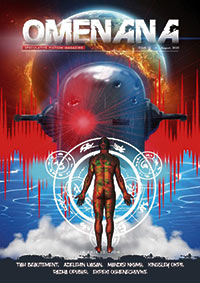 Omenana, <omenana.com>, speculative fiction “from across Africa and the African Diaspora,” published 12 original stories in two issues. Co-founder and managing editor Chiagozie Nwonwu said, “2020 was brutal, in every way it could be. We are hoping 2021 would be better and we can get back to our mostly drab normal lives. Radha Zutshi Opubor, a 16-year-old writer, was a pleasant discovery that we expect so much from in the future. Her story ‘The Beginning’ is one of our favourites this year. Ada Nnadi is another writer to watch.”
Omenana, <omenana.com>, speculative fiction “from across Africa and the African Diaspora,” published 12 original stories in two issues. Co-founder and managing editor Chiagozie Nwonwu said, “2020 was brutal, in every way it could be. We are hoping 2021 would be better and we can get back to our mostly drab normal lives. Radha Zutshi Opubor, a 16-year-old writer, was a pleasant discovery that we expect so much from in the future. Her story ‘The Beginning’ is one of our favourites this year. Ada Nnadi is another writer to watch.”
Lackington’s, <lackingtons.com>, published two scheduled issues and 14 stories. Ranylt Richildis, editor-in-chief, said, “We would love to see more hard SF, space opera, and heroic fantasy–we hardly ever get submissions in those veins…. We’ve tailored our upcoming ‘Battles’ call in February 2021 precisely to encourage some of those.” Pay was C$.01/word, $25 minimum, and C$25-C$40 for artwork. [Semiprozine]
Reckoning, <reckoning.press/>, “a nonprofit, annual journal of creative writing on environmental justice,” published 13 original and one reprint stories, 21 poems, plus essays in two print and digital issues. “I can say the best responses were for surreal and/or deeply personal, contemporary or near-future stories dealing with the loss, hardship, fear and grief pursuant human-caused environmental catastrophe, up to and including pandemic.” Pay was $0.08/word for fiction, $30/page for poetry. There were 10 Patreon supporters, about 50 ebook sales, 20 print sales. [Semiprozine]
Translunar Travelers Lounge, <translunartravelerslounge.com> edited by Aimee Ogden & Bennett North, published 28 stories including one reprint in two issues. Pay was $.03/word with a $20 minimum for flash fiction. “We are always looking for more genuinely kind stories – not necessarily in the world we’re shown, but in how the people move through it. Other than that, we’d love to see more submissions from Black and Latinx writers….” Visitors/month fluctuates, up to 1,300 during publication months [not eligible yet]
Non-profit Electric Spec, <www.electricspec.com>, published four scheduled issues with 20 original stories. Editors were Nikki Baird, Lesley L. Smith & Grayson Towler. Pay was $20/story. [Semiprozine]
Little Blue Marble, <littlebluemarble.ca>, published and edited by Katrina Archer, published 23 stories, three reprints and 22 originals, and two poems online. “I would like to see more optimistic fiction, and fewer apocalypses.” Pay was $.08/word. They had uniques of 370/month. [Semiprozine]
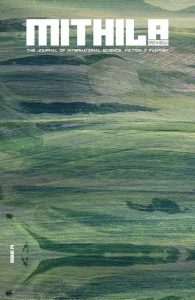 Mithila, <mithilareview.com>, published two issues with 13 original stories and two reprints. Editor Salik Shah said, “We are expanding our editorial team. The new team will be announced soon.” Pay was $10.00. [Semiprozine]
Mithila, <mithilareview.com>, published two issues with 13 original stories and two reprints. Editor Salik Shah said, “We are expanding our editorial team. The new team will be announced soon.” Pay was $10.00. [Semiprozine]
Three-Lobed Burning Eye, <www.3lobedmag.com>, edited by Andrew S. Fuller, published 12 original and 24 reprint stories in two issues and an anthology, saying, “We read over 2,900 submissions this year to find 12 stories. We are catching up with our print anthologies, and printed a collection of back issues with all new artwork. Next year we plan to add Patreon and other support plans to help raise our pay rates. Weird and strange fiction that has no hard genre group seem to receive the most online visitors. We hope to continue exploring this landscape, somewhere around the speculative, magical realism, slipstream, interstitial regions. We are always looking for more Black voices, Indigenous voices, LGBTQIA+ voices, and stories from around the world.” They had 1,800 visitors/month, 30+ ebook purchases/month, and 70 subscribers. $100/short story, $30/flash fiction. [Semiprozine]
There was one issue of Neo-opsis, <www.neo-opsis.ca>, 102 pages, with six stories and some non-fiction. Editor was Karl Johanson. Accordingto Karl and Stephanie Johanson, “from issue 31 on Neo-opsis Science Fiction Magazine will become a digital-only publication. We regret having to make this decision, but increases to the costs of paper, printing, mailing/distributing, and the complications around running a business in the times of COVID-19, and other factors have made this decision a necessity.” There were 120 subscribers, same as last year, and around 50 other assorted sales. Cover price was C$5.00, or three issues for C$12.00, six for C$21, nine for C$30, or C$100 for all issues. Fiction pay rate was C$.025/word, capping at $125. [Semiprozine]
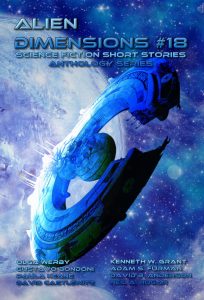 There was one issue of Alien Dimensions, <aliendimensions.com>, perfect bound, 15 x 23 cm, 104 pages, with glossy color covers and b&w interiors, including 9 original short stories. The magazine was available in ebook and POD. Editor Neil A. Hogan said, “It was great that one of the stories from issue #17 made the short list for the Aurealis awards, “Sky Tears” by Mike Adamson. Alien Dimensions is transitioning to be purely space fiction with aliens, so that’s what I’d like to see more of.” Print cover price was $7.95, ebook $2.99, or free with subscription to Kindle Unlimited. Pay rate was $10 per story. [Semiprozine]
There was one issue of Alien Dimensions, <aliendimensions.com>, perfect bound, 15 x 23 cm, 104 pages, with glossy color covers and b&w interiors, including 9 original short stories. The magazine was available in ebook and POD. Editor Neil A. Hogan said, “It was great that one of the stories from issue #17 made the short list for the Aurealis awards, “Sky Tears” by Mike Adamson. Alien Dimensions is transitioning to be purely space fiction with aliens, so that’s what I’d like to see more of.” Print cover price was $7.95, ebook $2.99, or free with subscription to Kindle Unlimited. Pay rate was $10 per story. [Semiprozine]
Baffling, <bafflingmag.com>, published four stories in their inaugural issue. Published by Neon Hemlock, the magazine is co-edited by Craig L. Gidney & dave ring, who said, “Our next issue will be January 1, 2021, with twice as many stories. Our strongest response was to “Velvert” by Nino Cipri.” Pay was $.08/word. “We’re still new, but it looks like our averages are 1.2k visitors a month.” [not yet eligible]
Arsenika, <arsenika.ink>, edited by S. Qiouyi Lu, published four flash pieces and 16 poems in three issues. Pay was $60 for flash fiction, $30 for poetry. “I was particularly proud of selecting fiction for Issue 7 about representation in a way that other magazines have either rejected and/or not understood.” They had 650 visitors/month, “about 1,200 page views.” [Semiprozine]
In poetry, we received three issues of Dreams & Nightmares, <www.dreamsandnightmaresmagazine.com>, priced at $5.00 (less for subscribers) with 49 original poems. Print run was 140, with a subscriber base of 88. Editor David Kopaska-Merkel said, “I am looking most for poems that have both a unique perspective on some speculative element and something directly personal, as opposed to dry exploration of the concept.” Pay rate was $12/poem. [Semiprozine]
Star*Line, <www.sfpoetry.com/starline.html>, the journal of the Science Fiction and Fantasy Poetry Association, produced four issues priced at $5.00, with 287 original poems. The print run was 300 copies/issue with a distribution of 280, and 211 PDF-only members. Pay rate was $.03/word, minimum $3, maximum $25. Vince Gotera edited the first two issues, F.J. Bergmann edited the third, and Melanie Stormm edited the fourth, dedicated to Black Lives Matter. Bergmann will start out 2021, to be followed by Jean-Paul Garnier, named the next Star*Line editor. The SFPA also published 81 poems in Eye to the Telescope, a quarterly online speculative poetry journal with a different theme and editor each issue: <www.eyetothetelescope.com>. [Semiprozine]
 We saw three issues of Vastarien, <www.grimscribepress.com>; and the inaugural three issues of SF/F magazine Cossmass Infinities <www.cossmass.com>. There were two issues each of Conjunctions, <www.conjunctions.com>, themed “Earth Elegies” and “Grendel’s Kin”, and Curiosities, <gallerycurious.com>, a retropunk magazine. We saw one issue each of Phantom Drift, <phantomdrift.org>; Planet Scumm, <www.planetscumm.space> and the first issue of Weird Horror <www.undertowpublications.com>. Cemetery Dance <www.cemeterydance.com> general manager Brian James Freeman reported that the release date for the next issue has been pushed back to February 2021. We did not see any issues of Amazing Stories, but one issue was available in print and digital at <www.amazingstories.com>. A number of venues appeared to have no issues last year, went on hiatus, didn’t return from hiatus (yet), or declared themselves defunct, so we have no entries for Science Fiction Trails, Red Sun, Kasma, Capricious, Helios Quarterly, Factor Four, Constellary Tales, IGMS, Compelling Science Fiction, and Apex – but Apex will be back in 2021, so make sure to check it out.
We saw three issues of Vastarien, <www.grimscribepress.com>; and the inaugural three issues of SF/F magazine Cossmass Infinities <www.cossmass.com>. There were two issues each of Conjunctions, <www.conjunctions.com>, themed “Earth Elegies” and “Grendel’s Kin”, and Curiosities, <gallerycurious.com>, a retropunk magazine. We saw one issue each of Phantom Drift, <phantomdrift.org>; Planet Scumm, <www.planetscumm.space> and the first issue of Weird Horror <www.undertowpublications.com>. Cemetery Dance <www.cemeterydance.com> general manager Brian James Freeman reported that the release date for the next issue has been pushed back to February 2021. We did not see any issues of Amazing Stories, but one issue was available in print and digital at <www.amazingstories.com>. A number of venues appeared to have no issues last year, went on hiatus, didn’t return from hiatus (yet), or declared themselves defunct, so we have no entries for Science Fiction Trails, Red Sun, Kasma, Capricious, Helios Quarterly, Factor Four, Constellary Tales, IGMS, Compelling Science Fiction, and Apex – but Apex will be back in 2021, so make sure to check it out.
PODCASTS
AUDIO FICTION
Marguerite Kenner, COO of Escape Artists, Inc., said, “Escape Pod was honored to receive another Hugo nomination, and published its first anthology with Titan Books to celebrate its 15th anniversary. Escape Pod also collaborated with Six to Start to produce a science fiction virtual race, written by Mur Lafferty and Alasdair Stuart. PodCastle was an inaugural Ignyte Award finalist, and both PodCastle and PseudoPod picked up British Fantasy Society nominations in 2020. EA announced it will start paying its associate editors (“slush readers”) as of January 2021, despite still being short of its Patreon goal. EA rolled out a Twitch channel and now streams weekly. Highlights included the serialisation of ‘A Wizard’s Guide to Defensive Baking’ by T. Kingfisher, and an interview with Jonathan Sims regarding his debut horror novel, Thirteen Storeys.” All four markets pay $0.08/word for original fiction, $100/story for reprints, and $20/flash fiction reprint. [Semiprozine]
There were 54 episodes of Escape Pod, <www.escapepod.org>, “The Science Fiction Podcast Magazine,” with 58 stories. PodCastle, <www.podcastle.org>, produced 53 episodes with 52 fantasy stories. PseudoPod, <www.pseudopod.org>, “the sound of horror,” produced 56 episodes with 66 stories. Cast of Wonders <www.castofwonders.org> published 49 episodes with 42 stories.
StarShipSofa, <www.starshipsofa.com>, produced and hosted by Tony C. Smith, published 32 episodes with 32 stories. Pay was $50/story. [Semiprozine]
Tales to Terrify, <talestoterrify.com>, owned and hosted by Drew Sebesteny and edited by Seth Williams, published 80 stories in podcast format, “about 60% original, 40% reprint,” in 52 regular episodes and 12 bonus “flashback” episodes. Sebesteny said, “This year, stories that were either particularly weird/quirky/funny or heartfelt seemed to strike a real chord with people. ‘The Husband Suit’ by Evan J. Peterson was a sleeper hit. Different than most of what we publish, but such an entertaining and oddly insightful story. ‘Every Time She Kills Him’ by JAW McCarthy was also a staff favourite.” Average unique visitors were 20,000/month, with about 45,000 episode downloads per month. Pay was $50/story. [Semiprozine]
Drabblecast, <www.drabblecast.org>, “off-beat, funny, eclecticism in science fiction, fantasy, and horror,” hosted, produced, and narrated by Norm Sherman, published one story by Tim Pratt. Pay was $.06/word for original fiction and $.03/word for reprint fiction.
Glittership, <www.glittership.com>, edited by Keffy R.M. Kehrli, published one podcast with one reprint, along with text. Pay was $.03/word for originals.
FANCASTS
Jennifer Mace, Freya Marske, and Alexandra Rowland produced 26 episodes of Be the Serpent <betheserpent.podbean.com> “about everything from academic mythology to dick jokes (and sometimes, both at once).” Rowland said, “We got our second Hugo nomination, which was a huge honor.” Standout episodes included discussion of “The Untamed (aka Mo Dao Zu Shi)” with guest Ruoxi Chen, and one on mermaids. Downloads averaged 7,600 per month. [Fancast]
Michelle Graham & Giles Hash co-hosted Beyond the Trope, <beyondthetrope.com>, publishing 50 episodes exploring “the deeper side of pop culture.” “We’ve had more unique downloads this year than in any previous year, and more publishers and authors are reaching out to help them promote their upcoming releases….” Interviews included Hank Green and Susan Spann. Average downloads per month were 4,300. [Fancast]
The Coode Street Podcast, <jonathanstrahan.podbean.com>, with hosts Jonathan Strahan & Gary K. Wolfe, published 178 episodes, 152 of which were “Ten Minutes with…” interviews asking editors, writers, artists, and other genre creatives about their pandemic experiences. Popular episodes included “year in review” and “books to discuss” posts, as well as discussions with N.K. Jemisin and Ken Liu. Episodes averaged 1,014 downloads, for a total of 190,200, with 1,400 subscribers. [Fancast]
Fangirl Happy Hour, <www.fangirlhappyhour.com>, “on the intersections of fandom, literature, and culture,” produced four episodes in 2020, with interviews and reviews. Hosts are Ana & Renay, co-editors of The Book Smugglers and Lady Business, respectively. [Fancast]
In their 10th year, Functional Nerds, <www.functionalnerds.com>, posted 47 of 48 scheduled episodes focusing on SF/F media. Patrick Hester said, “Co-founder and co-host, John Anealio, stepped away from the show in March, to spend more time with his family.” Tracy Townsend started as new co-host in April. Guests included K.C. Alexander, Jennifer Brody & Jules Rivera, Zig Zag Claybourne, Eboni Dunbar, Stephen Graham Jones, Anaea Lay, Rebecca Roanhorse, and more. Episodes averaged 2,000 downloads each. [Fancast]
Galactic Suburbia, <galactisuburbia.podbean.com>, with hosts Alisa Krasnostein, Alex Pierce, and Tansy Rayner Roberts, produced two podcast episodes of SF news and commentary before going on hiatus. [Fancast]
Geek’s Guide to the Galaxy, <geeksguideshow.com>, hosted by David Barr Kirtley and produced by John Joseph Adams, published 52 weekly episodes with “conversations about fantasy & science fiction in books, movies, games, and comics, as well as related subjects such as science, history, and critical thinking.” Popular episodes were TV reviews of Watchmen, His Dark Materials, The Mandalorian, and The Witcher, and an interview with Wil Wheaton. They had 20,000 unique visitors per month. [Related Work]
Our Opinions Are Correct, <www.ouropinionsarecorrect.com>, hosted by Charlie Jane Anders & Annalee Newitz, produced 26 episodes of deep dives into SF books, movies, television, and comics. The most popular were”about Lovecraft/Campbell, indigenous futurism, portal fantasies, writing plots and dialogue, new TV shows we love, and (not surprisingly) pandemics.” [Fancast]
The Skiffy and Fanty Show, <skiffyandfanty.com>, with hosts Shaun Duke and Jen Zink, published 58 of 65 scheduled episodes including “drunken reviews of bad movies, discussions of new and classic SF/F film and TV, interviews with authors, book club conversations,” and more. Duke said, “We made a radical shift over the summer… to a show focused more exclusively on the contributions of black creators to SF/F/H. In 2021, we’re continuing that mission and expanding to othermarginalized identities.” Interviews included P. Djèlí Clark, Tracy Deonn, and Andrea Hairston. Episodes averaged 1,500-2,000 downloads. [Fancast]
Writing Excuses, <www.writingexcuses.com>, produced their 15th season with 52 educational episodes by writers for writers. Hosted by “core cast” Margaret Dunlap, Mary Robinette Kowal, Mahtab Narisiman, Brandon Sanderson, Howard Tayler, and Dan Wells, with special guests in 2020 including Jim Butcher, Cory Doctorow, Eric Flint, Shannon & Dean Hale, Shauna Hoffman, Patrick Rothfuss, V.E. Schwab, Alex Shvartsman, David Weber, and others. [Related Work]
CRITICAL MAGAZINES
We saw one issue of The Cascadia Subduction Zone: A Literary Quarterly, <www.thecsz.com>, published by Aqueduct, with short fiction, poems, reviews, and art. Cover price was $5.00. Managing editor was Arrate Hidalgo. Other editors were Nisi Shawl, L. Timmel Duchamp, and Kath Wilham. [Related Work]
There were three issues of scholarly journal Extrapolation, published by Liverpool University Press, totaling 367 pages, with essays on Afrofuturism and a variety of other critical topics. Andrew Butler was managing editor. Print and PDF available at <online.liverpooluniversitypress.co.uk/loi/extr>. [Related Work]
We saw three issues of academic journal Foundation, <www.sf-foundation.org/>. Editor Paul March-Russell said, “The social, economic and racial inequalities that Covid-19 highlighted, allied to the George Floyd protests, magnified the theme I spotted last year – decolonisation in all areas of cultural life. To that end, we are running a ‘decolonising SF’ issue in 2021.” Print runs are 280 copies, with a subscriber base of 230-250. [Related Work]
Kevin J. Maroney published three issues of The New York Review of Science Fiction <www.nyrsf.com/toc>, with 183 subscribers, and 80 daily website hits. Pay rate was $40 for features, $20 for reviews, and $10 for short features. Maroney said, “2020 was a protracted kick in the gonads. Our plan for 2021 is to get back to six issues, preferably every other month, and to run more book reviews.” He also plans to have four years’ worth of issues available online. [Semiprozine]
Scholarly journal Science Fiction Studies, <www.depauw.edu/sfs>, published three issues, edited by Arthur Evans. The magazine was available in print and digital with access through JSTOR. They had approximately 800 subscribers, split evenly between individual and institutional, with 70% located withinthe US and 30% outside. Size of each issue increased from 160 pages to around 200. [Related Work]
There were four issues of Australian SF Commentary, with reviews, essays, and articles, and a John Bangsund tribute issue. Editor and publisher was Bruce Gillespie. Print was $A20 per issue; free PDFs available through <www.efanzines.com/SFC>. [Related Work]
SFRevu <www.sfrevu.com> successfully published monthly issues, free online, with 76 book reviews, 47 short fiction reviews, SF/F news, and columns. Senior editor was Gayle Surrette.
There were two issues of Vector, <vector-bsfa.com>, the critical journal of the British Science Fiction Association, edited by Polina Levontin & Jo Lindsay Walton, with articles and reviews on SF in books, games, television, music, and film. Issue 292 was a special themed issue on SFF and contemporary art, guest-edited by Rhona Eve Clews. Issue 293 will be a special on Chinese SFF guest-edited by Yen Ooi and Regina Kanyu Wang. The first 60 years of Vector‘s back catalog are now available for free download from <fanac.org>. We also saw two issues of Focus, the BSFA’s magazine for writers, edited by Dev Agarwal, as well as digital The BSFA Review. New annual fiction publication, Fission, is to be launched in 2021. [Related Work]
Two issues of Wormwood, edited by Mark Valentine, were available from Tartarus Press, with critical works exploring the fantastic, supernatural, and decadent in literature <www.tartaruspress.com/wormwood.html>. Print run was 300. Cover price was £9.99. [Semiprozine]
QUALITY
Our gauge for quality is based on our short fiction Recommended Reading list; see chart. We recommended 124 pieces of short fiction from 2020, down from 127. Recommended stories appeared in 25 magazines or online venues, up from last year’s 22. Anthologies had 12 recommended stories, down from last year’s 23, plus an additional four from collections, down from last year’s 14. Major anthologies were Dominion with four stories and The Book of Dragons with three, followed by Avatars Inc and Made to Order, both with two, and Final Cuts with one. Tor.com led the magazines/fiction sites with 13 stories, followed by Uncanny with 12, Beneath Ceaseless Skies with nine, Clarkesworld with seven, Strange Horizons with six, and Lightspeed with five. The remaining magazines had four or fewer recommended titles.
CONCLUSION
Once again this year we heard over and over that short fiction publishers are looking for humor, positive, or hopeful fiction, and that those stories receive the best audience response. It doesn’t take a lot of speculation to figure out why. There are also calls for more international and marginalized voices, and stories about diaspora and climate change. And the annual request for more science fiction, please.
The year 2020 being what it was, we don’t have a good sense of trends – there was a lot of hunkering down and surviving. We’re hoping some of those that went on hiatus this year will be back, but there are always new venues opening up for fiction, so we won’t run out soon. We’re still hearing that people are struggling to find funds to pay staff. There’s still lots of crowdfunding, and grants for those who aren’t in the US, but not a lot of magazines hitting the professional “paid one employee 25% of their income” marker.
Remember most of this amazing content is paid for, even if you get to read it for free, and that a lot of work goes into every part of it. The short fiction industry needs you to help keep it going by subscribing, donating, advertising, and supporting!
This summary and more like it in the February 2021 issue of Locus.
 While you are here, please take a moment to support Locus with a one-time or recurring donation. We rely on reader donations to keep the magazine and site going, and would like to keep the site paywall free, but WE NEED YOUR FINANCIAL SUPPORT to continue quality coverage of the science fiction and fantasy field.
While you are here, please take a moment to support Locus with a one-time or recurring donation. We rely on reader donations to keep the magazine and site going, and would like to keep the site paywall free, but WE NEED YOUR FINANCIAL SUPPORT to continue quality coverage of the science fiction and fantasy field.
©Locus Magazine. Copyrighted material may not be republished without permission of LSFF.








